The Influence of the Calibration Interval on Simulating Non-Stationary Urban Growth Dynamic Using CA-Markov Model
Abstract
1. Introduction
2. Materials and Methods
2.1. Definitions and Statements
2.2. Study Area
2.3. Dataset and Land Change Analysis
2.3.1. Dependent Variables—Past LUCC
2.3.2. Independent Variables—Constraints and Potential Driving Factors
2.4. CA-Markov Model
2.4.1. Transition Area Matrix Using a Markovian Process
2.4.2. CA-Markov Model
2.5. Accuracy Assessment
3. Results
3.1. Quantity of Change Estimate
3.2. Spatial Allocation of Change
4. Discussion
4.1. Quantity of Change Estimate
4.2. Spatial Allocation of Change
4.3. Implications on the Model Performance and Outputs
5. Conclusions
Funding
Institutional Review Board Statement
Informed Consent Statement
Data Availability Statement
Acknowledgments
Conflicts of Interest
References
- Brown, D.G.; Walker, R.; Manson, S.; Seto, K. Modeling Land Use and Land Cover Change. In Land Change Science; Springer: Dordrecht, The Netherlands, 2004; Volume 6, pp. 395–409. [Google Scholar]
- Masson, V.; Marchadier, C.; Adolphe, L.; Aguejdad, R.; Avner, P.; Bonhomme, M.; Bretagne, G.; Briottet, X.; Bueno, B.; De Munck, C.; et al. Adapting cities to climate change: A systemic modelling approach. Urban Clim. 2014, 10, 407–429. [Google Scholar] [CrossRef]
- Mallampalli, V.R.; Mavrommati, G.; Thompson, J.; Duveneck, M.; Meyer, S.; Ligmann-Zielinska, A.; Druschke, C.G.; Hychka, K.; Kenney, M.A.; Kok, K.; et al. Methods for translating narrative scenarios into quantitative assessments of land use change. Environ. Model. Softw. 2016, 82, 7–20. [Google Scholar] [CrossRef]
- Houet, T.; Marchadier, C.; Bretagne, G.; Moine, M.P.; Aguejdad, R.; Viguié, V.; Bonhomme, M.; Lemonsu, A.; Avner, P.; Hidalgo, J.; et al. Combining narratives and modelling approaches to simulate fine scale and long-term urban growth scenarios for climate adaptation. Environ. Model. Softw. 2016, 86, 1–13. [Google Scholar] [CrossRef]
- Camacho Olmedo, M.T.; Pontius, R.G., Jr.; Paegelow, M.; Mas, J.F. Comparison of simulation models in terms of quantity and allocation of land change. Environ. Model. Softw. 2016, 69, 214–221. [Google Scholar] [CrossRef]
- Noszczyk, T. A review of approaches to land use changes modelling. Hum. Ecol. Risk Assess. Int. J. 2019, 25, 1377–1405. [Google Scholar] [CrossRef]
- Agarwal, C.; Green, G.L.; Grove, M.; Evans, T.; Schweik, C. A Review and Assessment of Land-Use Change Models: Dynamics of Space, Time and Human Choice; General Technical Report NE-297; U.S. Department of Agriculture, Forest Service, Northeastern Research Station: Madison, WI, USA, 2000. [Google Scholar]
- Haase, D.; Schwarz, N. Simulation Models on Human-Nature Interactions in Urban Landscapes: A Review Including Spatial Economics, System Dynamics, Cellular Automata and Agent-Based Approaches. Living Rev. Landsc. Res. 2009, 3, 1–45. [Google Scholar] [CrossRef]
- Triantakonstantis, D.; Mountrakis, G. Urban Growth Prediction: A Review of Computational Models and Human Perceptions. J. Geogr. Inf. Syst. 2012, 4, 555–587. [Google Scholar]
- Van Vliet, J.; Bregt, A.K.; Brown, D.G.; van Delden, H.; Heckbert, S.; Verburg, P.H. A review of current calibration and validation practices in land-change modeling. Environ. Model. Softw. 2016, 82, 174–182. [Google Scholar] [CrossRef]
- Brown, D.G.; Verburg, P.H.; Pontius, R.G., Jr.; Lange, M.D. Opportunities to improve impact, integration, and evaluation of land change models. Curr. Opin. Environ. Sustain. 2013, 5, 452–457. [Google Scholar] [CrossRef]
- Mas, J.F.; Kolb, M.; Paegelow, M.; Camacho Olmedo, M.T.; Houet, T. Inductive pattern-based land use/cover change models: A comparison of four software packages. Environ. Model. Softw. 2014, 51, 94–111. [Google Scholar] [CrossRef]
- Burnicki, A.C.; Brown, D.G.; Goovaerts, P. Propagating error in land-cover-change analyses: Impact of temporal dependence under increased thematic complexity. Int. J. Geogr. Inf. Sci. 2010, 24, 1043–1060. [Google Scholar] [CrossRef]
- Santé, I.; García, A.M.; Miranda, D.; Crecente, R. Cellular automata models for the simulation of real-world urban processes: A review and analysis. Landsc. Urban Plan. 2010, 96, 108–122. [Google Scholar] [CrossRef]
- Mas, J.F.; Paegelow, M.; Camacho Olmedo, M.T. LUCC Modeling Approaches to Calibration. In Geomatic Approaches for Modeling Land Change Scenarios; Camacho Olmedo, M.T., Paegelow, M., Mas, J.F., Eds.; Lecture notes in Geoinformation and Cartography; Springer International Publishing AG.: Cham, Switzerland, 2018; Chapter 2; pp. 11–25. [Google Scholar]
- Van Vliet, J.; Naus, N.; van Lammeren, R.J.A.; Bregt, A.K.; Hurkens, J.; van Delden, H. Measuring the neighbourhood effect to calibrate land use models. Comput. Environ. Urban Syst. 2013, 41, 55–64. [Google Scholar] [CrossRef]
- Chen, Y.M.; Li, X.; Liu, X.P.; Ai, B. Modeling urban land-use dynamics in a fast developing city using the modified logistic cellular automaton with a patch-based simulation strategy. Int. J. Geogr. Inf. Sci. 2014, 28, 234–255. [Google Scholar] [CrossRef]
- Bennett, N.D.; Croke, B.F.W.; Guariso, G.; Guillaume, J.H.; Hamilton, S.H.; Jakeman, A.J.; Marsili-Libelli, S.; Newham, L.T.H.; Norton, J.P.; Perrin, C.; et al. Characterizing performance of environmental models. Environ. Model. Softw. 2013, 40, 1–20. [Google Scholar] [CrossRef]
- Pickard, B.; Gray, J.; Meentemeyer, R. Comparing Quantity, Allocation and Configuration Accuracy of Multiple Land Change Models. Land 2017, 6, 52. [Google Scholar] [CrossRef]
- Aguejdad, R.; Houet, T.; Hubert-Moy, L. Spatial validation of land-use change models using multiple assessment techniques: A case study of transition potential models. Environ. Model. Assess. 2017, 22, 591–606. [Google Scholar] [CrossRef]
- Aguejdad, R.; Doukari, O.; Houet, T.; Avner, P.; Viguié, V. Modélisation prospective de l’étalement urbain: Apports et limites des modèles de spatialisation. Application aux modèles SLEUTH, LCM et NEDUM-2D. Cybergeo Eur. J. Geogr. 2016, 782. [Google Scholar] [CrossRef]
- Lambin, E.F.; Geist, H.J.; Lepers, E. Dynamics of land-use and land-cover change in tropical regions. Annu. Rev. Environ. Resour. 2003, 28, 205–241. [Google Scholar] [CrossRef]
- Kolb, M.; Mas, J.F.; Galicia, L. Evaluating drivers of land-use change and transition potential models in a complex landscape in Southern Mexico. Int. J. Geogr. Inf. Sci. 2013, 27, 1804–1827. [Google Scholar] [CrossRef]
- Verstegen, J.A.; Karssenberg, D.; van der Hilst, F.; Faaij, A.P.C. Detecting systemic change in a land use system by Bayesian data assimilation. Environ. Model. Softw. 2015, 75, 424–438. [Google Scholar] [CrossRef]
- Eastman, J.R.; van Fossen, M.E.; Solorzano, L.A. Transition Potential Modeling for Land Cover Change. In GIS, Spatial Analysis and Modeling; Maguire, D., Batty, M., Goodchild, M., Eds.; ESRI Press: Redlands, CA, USA, 2005; pp. 357–386. [Google Scholar]
- Pérez-Vega, A.; Mas, J.F.; Ligmann-Zielinska, A. Comparing two approaches to land use/cover change modeling and their implications for the assessment of biodiversity loss in a deciduous tropical forest. Environ. Model. Softw. 2012, 29, 11–23. [Google Scholar] [CrossRef]
- Paegelow, M.; Camacho Olmedo, M.T.; Mas, J.F.; Houet, T. Benchmarking of LUCC modelling tools by various validation techniques and error analysis. Cybergeo Eur. J. Geogr. 2014, 701. [Google Scholar] [CrossRef]
- Bürgi, M.; Hersperger, A.M.; Scheneeberger, N. Driving forces for landscape change—Current and new directions. Landsc. Ecol. 2004, 19, 857–868. [Google Scholar] [CrossRef]
- Blecic, I.; Cecchini, A.; Trunfio, G.A. How much past to see the future: A computational study in calibrating urban cellular automata. Int. J. Geogr. Inf. Sci. 2015, 29, 349–374. [Google Scholar] [CrossRef]
- Pontius, R.G., Jr.; Huffaker, D.; Denman, K. Useful techniques of validation for spatially explicit land-change models. Ecol. Model. 2004, 179, 445–461. [Google Scholar] [CrossRef]
- Wu, X.; Hu, Y.; He, H.S.; Bu, R.; Xi, F. Performance Evaluation of the SLEUTH Model in the Shenyang Metropolitan Area of Northeastern China. Environ. Model. Assess. 2009, 14, 221–230. [Google Scholar] [CrossRef]
- Van Vliet, J.; Bregt, A.K.; Hagen-Zanker, A. Revisiting Kappa to account for change in the accuracy assessment of land-use change models. Ecol. Model. 2011, 222, 1367–1375. [Google Scholar] [CrossRef]
- Runfola, D.S.M.; Pontius, R.G., Jr. Measuring the temporal instability of land change using the Flow matrix. Int. J. Geogr. Inf. Sci. 2013, 27, 1696–1716. [Google Scholar] [CrossRef] [PubMed]
- Wang, H.; Stephenson, S.R.; Qu, S. Modeling spatially non-stationary land use/cover change in the lower Connecticut River Basin by combining geographically weighted logistic regression and the CA-Markov model. Int. J. Geogr. Inf. Sci. 2019, 33, 1313–1334. [Google Scholar] [CrossRef]
- Müller, D.; Sun, Z.; Vongvisouk, T.; Pflugmacher, D.; Xu, J.; Mertz, O. Regime shifts limit the predictability of land-system change. Glob. Environ. Chang. 2014, 28, 75–83. [Google Scholar] [CrossRef]
- Eastman, J.R. IDRISI Selva Help System; IDRISI Selva Version: 17; Clark Labs, Clark University: Worcester, MA, USA, 2012. [Google Scholar]
- Camacho Olmedo, M.T.; Paegelow, M.; Mas, J.F. Interest in intermediate soft-classified maps in land change model validation: Suitability versus transition potential. Int. J. Geogr. Inf. Sci. 2013, 27, 2343–2361. [Google Scholar] [CrossRef]
- Yang, X.; Zheng, X.Q.; Chen, R. A land use change model: Integrating landscape pattern indexes and Markov-CA. Ecol. Model. 2014, 283, 1–7. [Google Scholar] [CrossRef]
- Petit, C.; Scudder, T.; Lambin, E. Quantifying processes of land-cover change by remote sensing: Resettlement and rapid land-cover changes in south-eastern Zambia. Int. J. Remote Sens. 2001, 22, 3435–3456. [Google Scholar]
- Takada, T.; Miyamoto, A.; Hasegawa, S. Derivation of a yearly transition probability matrix for land-use dynamics and its applications. Landsc. Ecol. 2010, 25, 561–572. [Google Scholar]
- Bell, E.; Hinojosa, R. Markov analysis of land use change: Continuous time and stationary processes. Socio. Econ. Plan. Sci. 1977, 11, 13–17. [Google Scholar] [CrossRef]
- Lambin, E.F. Modelling Deforestation Processes: A Review; TREES series B: Research Report 1, European Commission, EUR 15744 EN; European Commission: Luxembourg, 1994. [Google Scholar]
- Subedi, P.; Subedi, K.; Thapa, B. Application of a Hybrid Cellular Automaton–Markov (CA-Markov) Modeling land use change prediction: A case study of Saddle Creek Drainage Basin, Florida. Appl. Ecol. Environ. Sci. 2013, 1, 126–132. [Google Scholar]
- Memarian, H.; Balasundram, S.K.; Talib, J.B.; Sung, C.T.B.; Sood, A.M.; Abbaspour, K. Validation of CA-markov for simulation of land use and cover change in the Langat Basin, Malaysia. J. Geogr. Inf. Syst. 2012, 4, 542–554. [Google Scholar] [CrossRef]
- Saaty, T.L. The Analytic Hierarchy Process; McGraw-Hill: New York, NY, USA, 1980. [Google Scholar]
- Saaty, T.L.; Vargas, L.G. Models, Methods, Concepts and Applications of the Analytic Hierarchy Process; Kluwer: Dordrecht, The Netherlands, 2001. [Google Scholar]
- Chen, H.; Pontius, R.G., Jr. Diagnostic tools to evaluate a spatial land change projection along a gradient of an explanatory variable. Landsc. Ecol. 2010, 25, 1319–1331. [Google Scholar] [CrossRef]
- Pontius, R.G., Jr.; Millones, M. Death to Kappa: Birth of quantity disagreement and allocation disagreement for accuracy assessment. Int. J. Remote Sens. 2011, 32, 4407–4429. [Google Scholar] [CrossRef]
- Pontius, R.G., Jr.; Peethambaram, S.; Castella, J.C. Comparison of three maps at multiple resolutions: A case study of land change simulation in Cho Don District, Vietnam. Ann. Am. Assoc. Geogr. 2011, 101, 45–62. [Google Scholar] [CrossRef]
- Ahmed, B.; Ahmed, R.; Zhu, X. Evaluation of Model Validation Techniques in Land Cover Dynamics. Int. J. Geo. Inf. 2013, 2, 577–597. [Google Scholar] [CrossRef]
- McGarigal, K.; Cushman, S.A.; Neel, M.C.; Ene, E. FRAGSTATS: Spatial Pattern Analysis Program for Categorical Maps; Computer Software Program Produced by the Authors at the University of Massachusetts; University of Massachusetts: Amherst, MA, USA, 2002. [Google Scholar]
- Herold, M.; Goldstein, N.C.; Clarke, K.C. The spatiotemporal form of urban growth: Measurement, analysis and modeling. Remote Sens. Environ. 2003, 86, 286–302. [Google Scholar]
- Herold, M.; Couclelis, H.; Clarke, K.C. The role of spatial metrics in the analysis and modeling of urban land use change. Comput. Environ. Urban Syst. 2005, 29, 369–399. [Google Scholar] [CrossRef]
- Aldwaik, S.Z.; Pontius, R.G., Jr. Intensity analysis to unify measurements of size and stationarity of land changes by interval, category, and transition. Landsc. Urban Plan. 2012, 106, 103–114. [Google Scholar] [CrossRef]
- Pontius, R.G., Jr.; Castella, J.C.; de Nijs, T.; Duan, Z.; Fotsing, E.; Goldstein, N.; Kok, K.; Koomen, E.; Lippitt, C.D.; McConnell, W.; et al. Lessons and Challenges in Land Change Modeling Derived from Synthesis of Cross-Case Comparisons. In Trends in Spatial Analysis and Modeling; Behnisch, M., Meine, G., Eds.; Geotechnologies and the Environment; Springer International Publishing AG.: Cham, Switzerland, 2018; Volume 19, pp. 143–164. [Google Scholar]
- Clarke, K.C.; Hoppen, S.; Gaydos, L. A self-modifying cellular automaton model of historical urbanization in the San Francisco Bay area. Environ. Plan. B Plan. Des. 1997, 24, 247–261. [Google Scholar] [CrossRef]
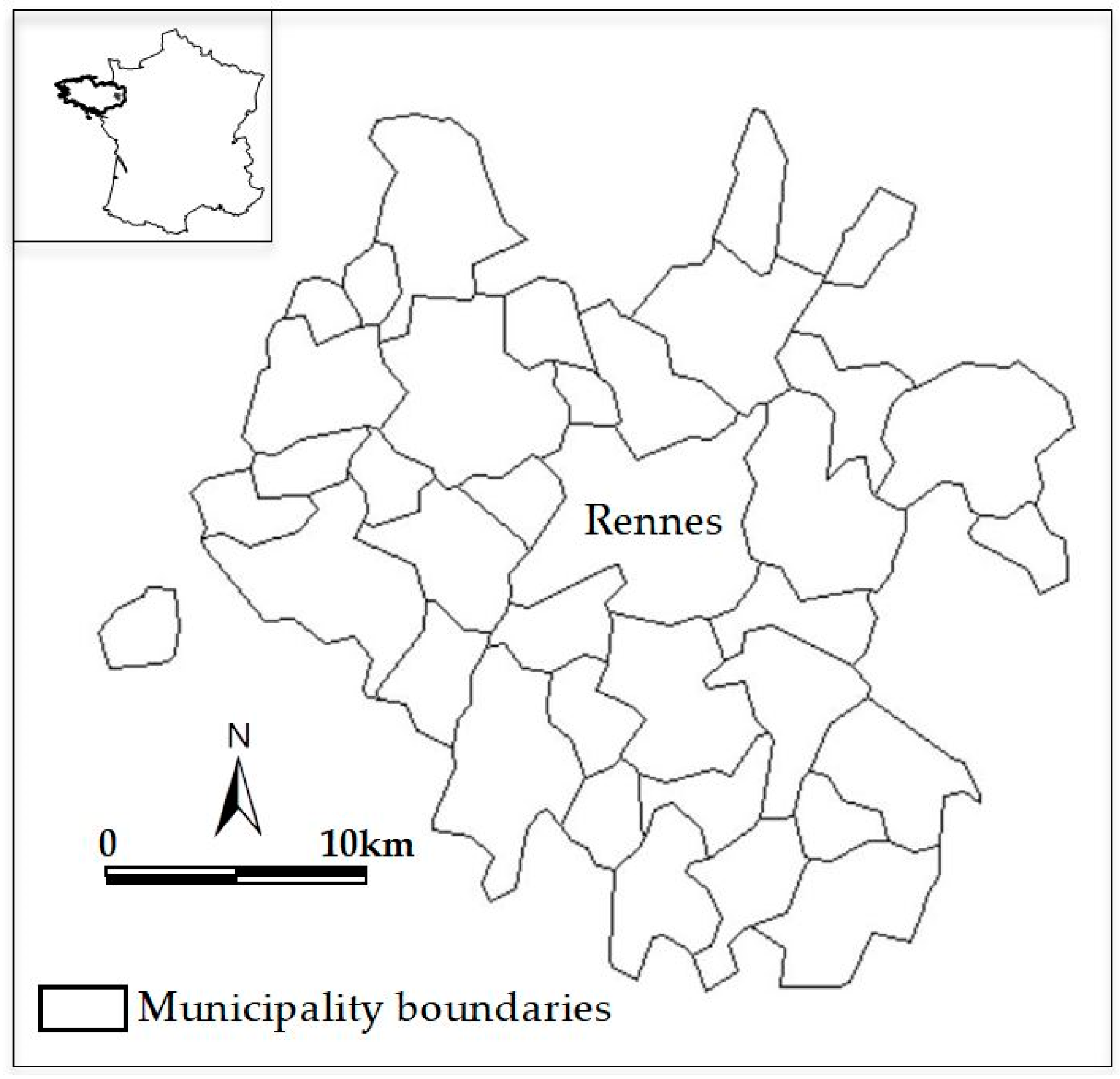

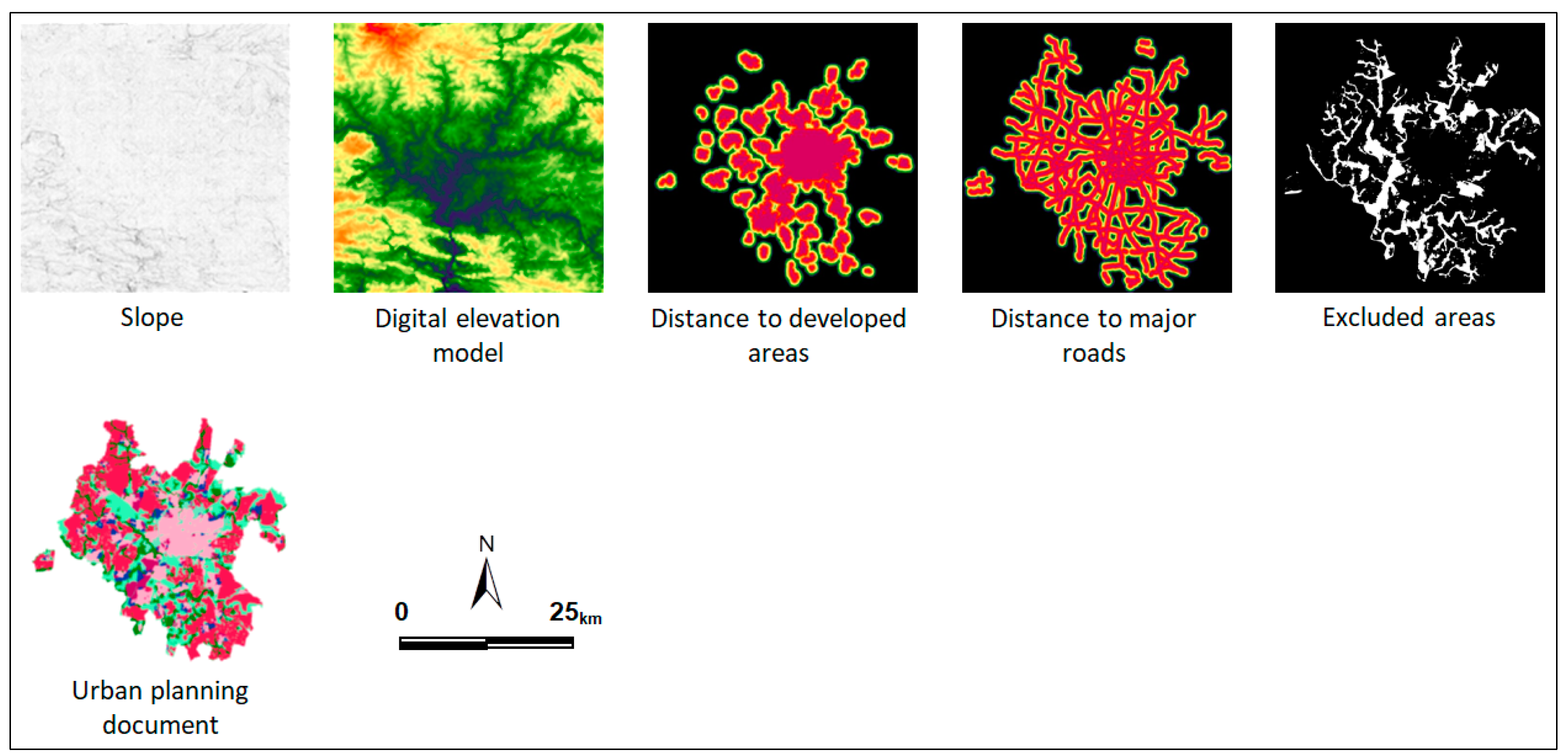


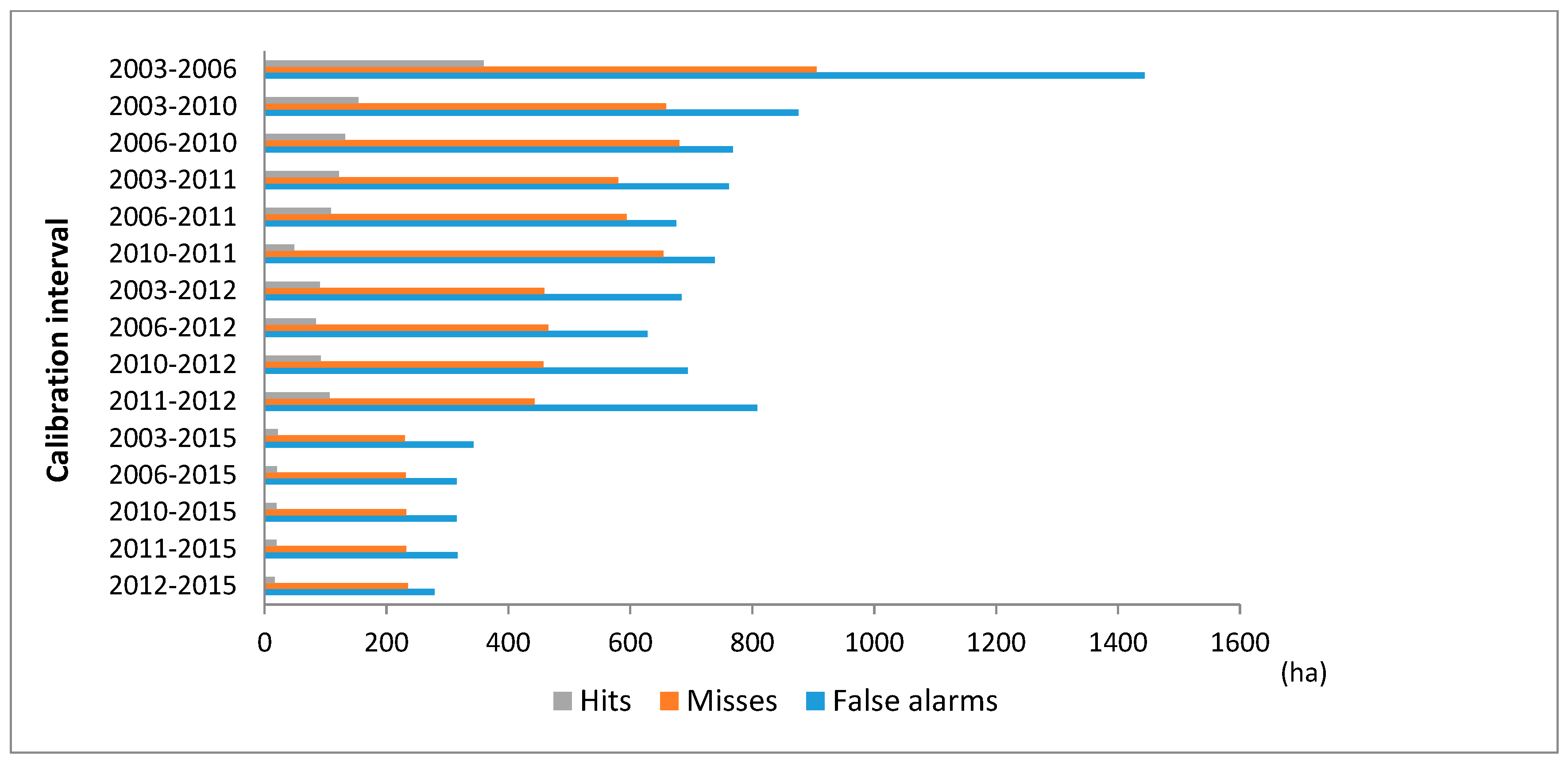


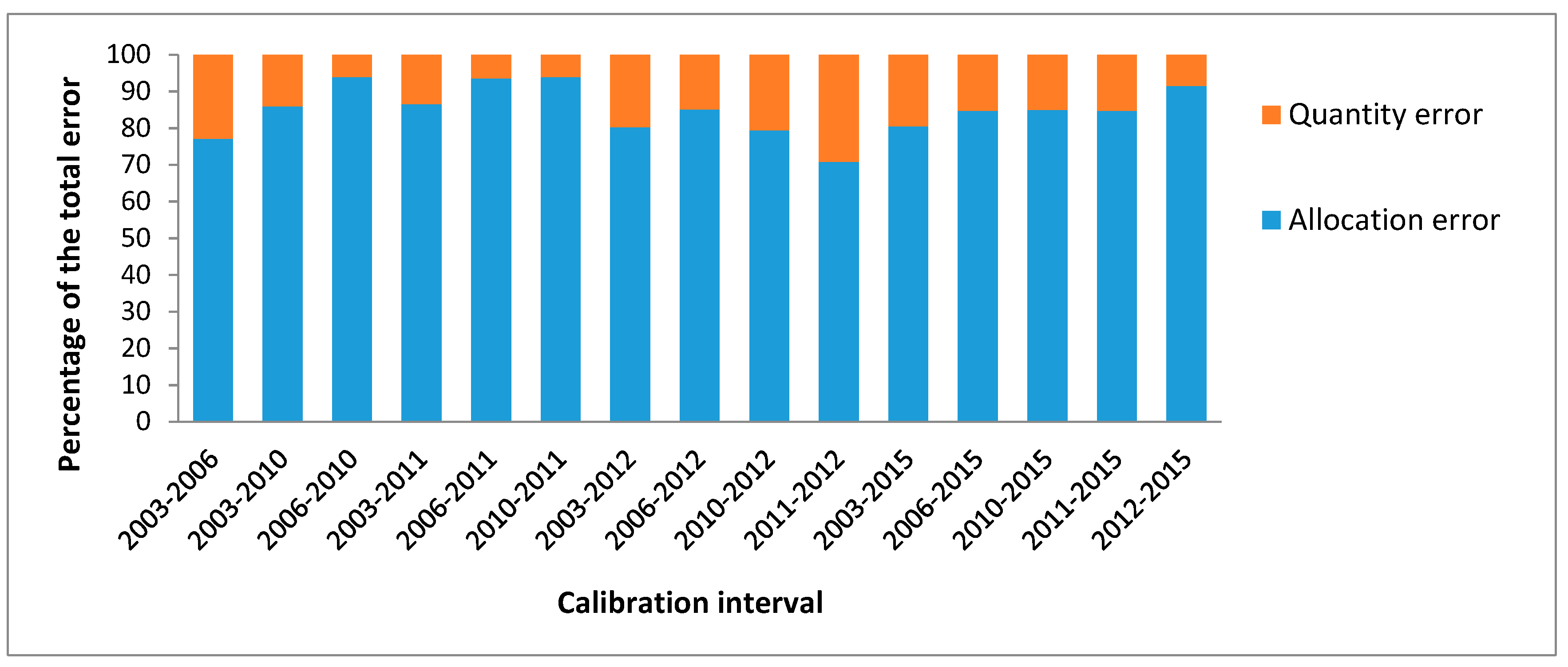
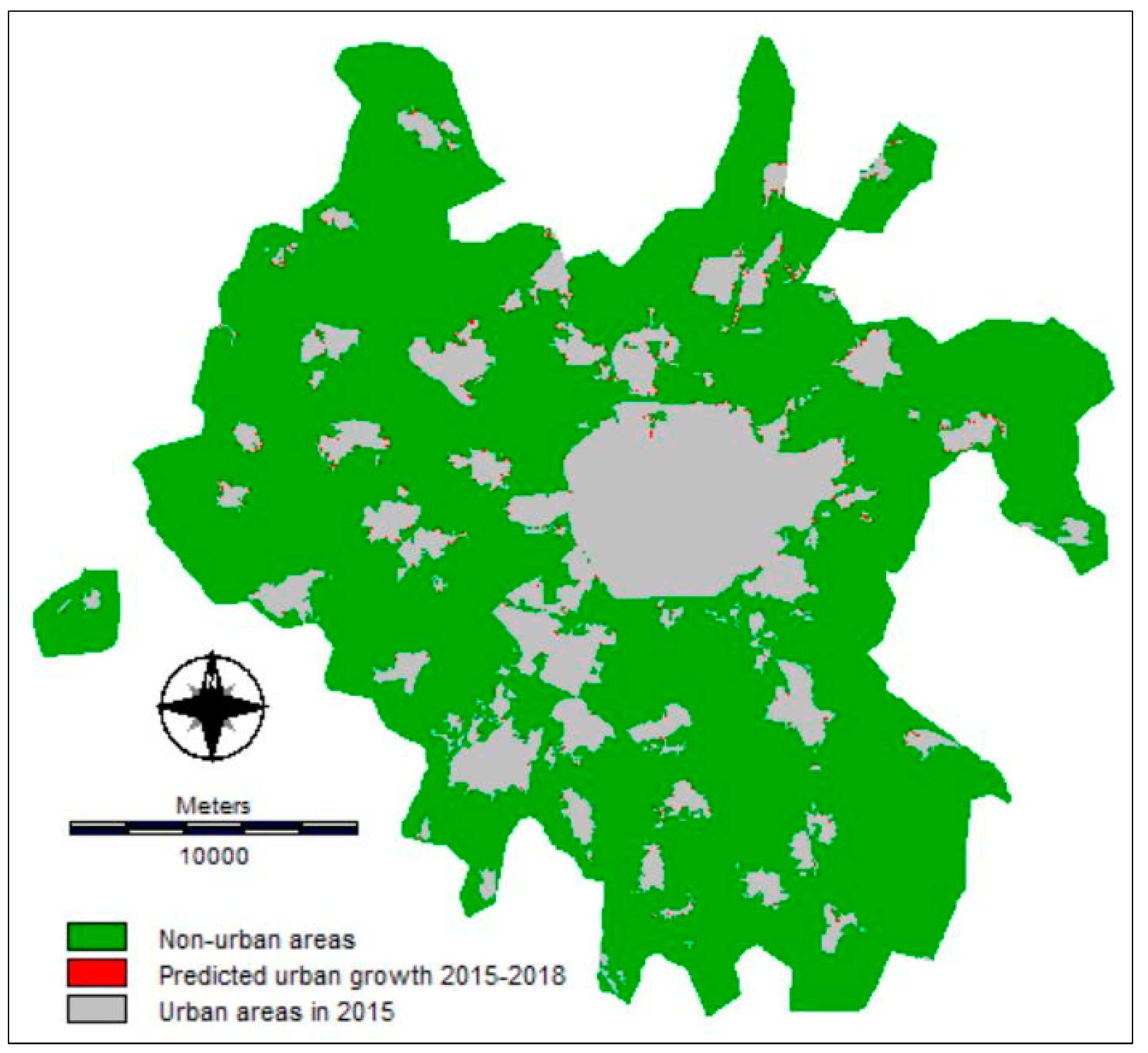
| Date | Area (ha) | Percentage of Landscape (%) | NP | ENND_MN | Period | Annual Change (ha/Year) | Growth Rate (%) |
|---|---|---|---|---|---|---|---|
| 2003 | 11,399 | 18.6 | 240 | 105 | - | - | |
| 2006 | 11,854 | 19.3 | 228 | 113 | 2003–2006 | 152 | 3.99 |
| 2010 | 12,307 | 20.1 | 227 | 106 | 2006–2010 | 113 | 3.82 |
| 2011 | 12,417 | 20.2 | 221 | 116 | 2010–2011 | 110 | 0.93 |
| 2012 | 12,570 | 20.5 | 222 | 115 | 2011–2012 | 153 | 1.23 |
| 2015 | 12,866 | 21.0 | 218 | 126 | 2012–2015 | 99 | 2.36 |
| 2018 | 13,118 | 21.4 | 218 | 137 | 2015–2018 | 84 | 1.96 |
| Calibration Interval | Simulation Interval | Error | ||||||||
|---|---|---|---|---|---|---|---|---|---|---|
| Period | ΔT (Year) | Observed Rate (A) (ha/Year) | Period | ΔT (year) | Observed Rate (B) (ha/Year) | Predicted Rate (C) (ha/Year) | Obs.-Pred. (B–C) (ha/Year) | A–B (ha/Year) | A–C (ha/Year) | EQuantity (ha) |
| 2003 | 3 | 152 | 2006 | 12 | 105 | 150 | −45 | 47 | 2 | −540 |
| 2006 | 2018 | |||||||||
| 2003 | 7 | 130 | 2010 | 8 | 101 | 129 | −28 | 29 | 1 | −224 |
| 2010 | 2018 | |||||||||
| 2003 | 8 | 127 | 2011 | 7 | 100 | 126 | −26 | 27 | 1 | −182 |
| 2011 | 2018 | |||||||||
| 2003 | 9 | 130 | 2012 | 6 | 91 | 129 | −38 | 39 | 1 | −228 |
| 2012 | 2018 | |||||||||
| 2003 | 12 | 122 | 2015 | 3 | 84 | 121 | −37 | 38 | 1 | −111 |
| 2015 | 2018 | |||||||||
| 2006 | 4 | 113 | 2010 | 8 | 101 | 113 | −12 | 12 | 0 | −96 |
| 2010 | 2018 | |||||||||
| 2006 | 5 | 113 | 2011 | 7 | 100 | 112 | −12 | 13 | 1 | −84 |
| 2011 | 2018 | |||||||||
| 2006 | 6 | 119 | 2012 | 6 | 91 | 119 | −28 | 28 | 0 | −168 |
| 2012 | 2018 | |||||||||
| 2006 | 9 | 112 | 2015 | 3 | 84 | 112 | −28 | 28 | 0 | −84 |
| 2015 | 2018 | |||||||||
| 2010 | 1 | 110 | 2011 | 7 | 100 | 112 | −12 | 10 | -2 | −84 |
| 2011 | 2018 | |||||||||
| 2010 | 2 | 132 | 2012 | 6 | 91 | 131 | −40 | 41 | 1 | −240 |
| 2012 | 2018 | |||||||||
| 2010 | 5 | 112 | 2015 | 3 | 84 | 112 | −28 | 28 | 0 | −84 |
| 2015 | 2018 | |||||||||
| 2011 | 1 | 153 | 2012 | 6 | 91 | 153 | −62 | 62 | 0 | −372 |
| 2012 | 2018 | |||||||||
| 2011 | 4 | 112 | 2015 | 3 | 84 | 112 | −28 | 28 | 0 | −84 |
| 2015 | 2018 | |||||||||
| 2012 | 3 | 99 | 2015 | 3 | 84 | 99 | −15 | 15 | 0 | −45 |
| 2015 | 2018 | |||||||||
| Intervals | False Alarms 2-1-1 | Misses 1-2-1 | Hits 2-2-1 | Persistent 2-2-2 | Quantity Error | Total Error | Allocation Error | |
|---|---|---|---|---|---|---|---|---|
| Calibration | Simulation | |||||||
| 2003–2006 | 2006–2018 | 1444 | 905 | 359 | 11,854 | 539 | 2349 | 1810 |
| 2003–2010 | 2010–2018 | 876 | 659 | 154 | 12,306 | 217 | 1535 | 1318 |
| 2006–2010 | 769 | 681 | 132 | 12,306 | 88 | 1450 | 1361 | |
| 2003–2011 | 2011–2018 | 762 | 580 | 122 | 12,416 | 181 | 1342 | 1161 |
| 2006–2011 | 676 | 594 | 109 | 12,416 | 81 | 1270 | 1188 | |
| 2010–2011 | 739 | 654 | 48 | 12,416 | 84 | 1393 | 1309 | |
| 2003–2012 | 2012–2018 | 684 | 459 | 91 | 12,569 | 225 | 1143 | 918 |
| 2006–2012 | 628 | 466 | 84 | 12,569 | 163 | 1094 | 931 | |
| 2010–2012 | 695 | 457 | 92 | 12,569 | 237 | 1152 | 915 | |
| 2011–2012 | 808 | 443 | 107 | 12,569 | 365 | 1251 | 886 | |
| 2003–2015 | 2015–2018 | 343 | 231 | 22 | 12,866 | 112 | 573 | 461 |
| 2006–2015 | 315 | 232 | 20 | 12,866 | 84 | 547 | 464 | |
| 2010–2015 | 315 | 232 | 20 | 12,866 | 83 | 547 | 465 | |
| 2011–2015 | 316 | 232 | 20 | 12,866 | 84 | 549 | 465 | |
| 2012–2015 | 279 | 235 | 17 | 12,866 | 44 | 514 | 471 | |
| Calibration Interval | NP | PD | Area-MN | ENND-MN | LSI | AI | LPI |
|---|---|---|---|---|---|---|---|
| 2003–2006 | 124 | 0.1 | 120 | 269 | 4.5 | 99.7 | 3.9 |
| 2003–2010 | 146 | 0.1 | 103 | 217 | 4.9 | 99.7 | 4.6 |
| 2006–2010 | 148 | 0.1 | 101 | 217 | 5.0 | 99.7 | 4.6 |
| 2003–2011 | 149 | 0.1 | 102 | 223 | 5.0 | 99.7 | 4.6 |
| 2006–2011 | 146 | 0.1 | 101 | 223 | 5.1 | 99.7 | 4.6 |
| 2010–2011 | 173 | 0.1 | 99 | 215 | 5.2 | 99.7 | 4.6 |
| 2003–2012 | 149 | 0.1 | 102 | 221 | 5.1 | 99.7 | 4.6 |
| 2006–2012 | 146 | 0.1 | 101 | 222 | 5.2 | 99.7 | 4.6 |
| 2010–2012 | 150 | 0.1 | 102 | 221 | 5.1 | 99.7 | 4.6 |
| 2011–2012 | 141 | 0.1 | 112 | 257 | 5.0 | 99.7 | 4.7 |
| 2003–2015 | 158 | 0.1 | 100 | 214 | 5.4 | 99.7 | 4.6 |
| 2006–2015 | 171 | 0.1 | 94 | 200 | 5.4 | 99.7 | 4.6 |
| 2010–2015 | 171 | 0.1 | 94 | 200 | 5.4 | 99.7 | 4.6 |
| 2011–2015 | 171 | 0.1 | 94 | 200 | 5.4 | 99.7 | 4.6 |
| 2012–2015 | 162 | 0.1 | 96 | 206 | 5.5 | 99.7 | 4.6 |
Publisher’s Note: MDPI stays neutral with regard to jurisdictional claims in published maps and institutional affiliations. |
© 2021 by the author. Licensee MDPI, Basel, Switzerland. This article is an open access article distributed under the terms and conditions of the Creative Commons Attribution (CC BY) license (http://creativecommons.org/licenses/by/4.0/).
Share and Cite
Aguejdad, R. The Influence of the Calibration Interval on Simulating Non-Stationary Urban Growth Dynamic Using CA-Markov Model. Remote Sens. 2021, 13, 468. https://doi.org/10.3390/rs13030468
Aguejdad R. The Influence of the Calibration Interval on Simulating Non-Stationary Urban Growth Dynamic Using CA-Markov Model. Remote Sensing. 2021; 13(3):468. https://doi.org/10.3390/rs13030468
Chicago/Turabian StyleAguejdad, Rahim. 2021. "The Influence of the Calibration Interval on Simulating Non-Stationary Urban Growth Dynamic Using CA-Markov Model" Remote Sensing 13, no. 3: 468. https://doi.org/10.3390/rs13030468
APA StyleAguejdad, R. (2021). The Influence of the Calibration Interval on Simulating Non-Stationary Urban Growth Dynamic Using CA-Markov Model. Remote Sensing, 13(3), 468. https://doi.org/10.3390/rs13030468






